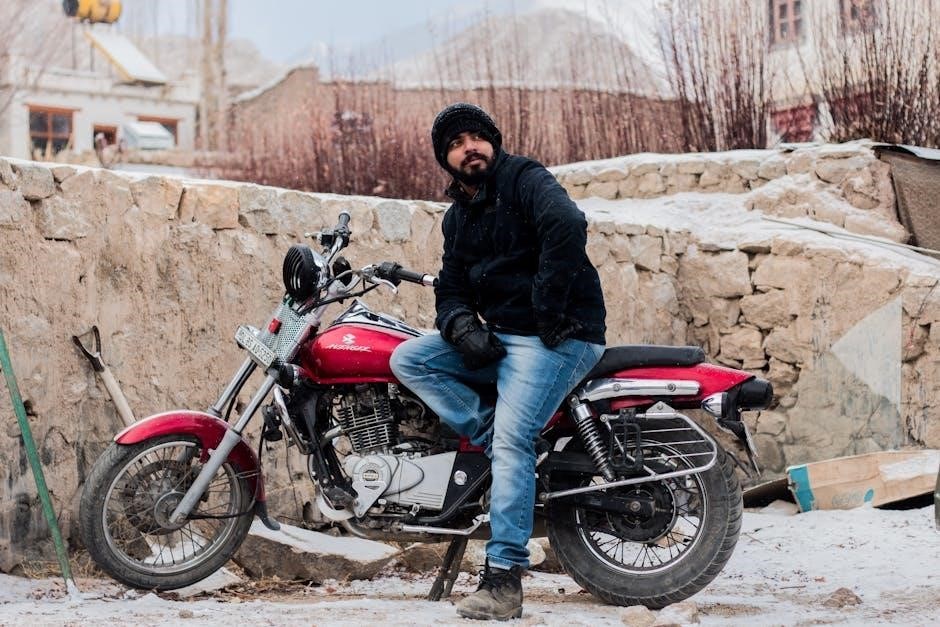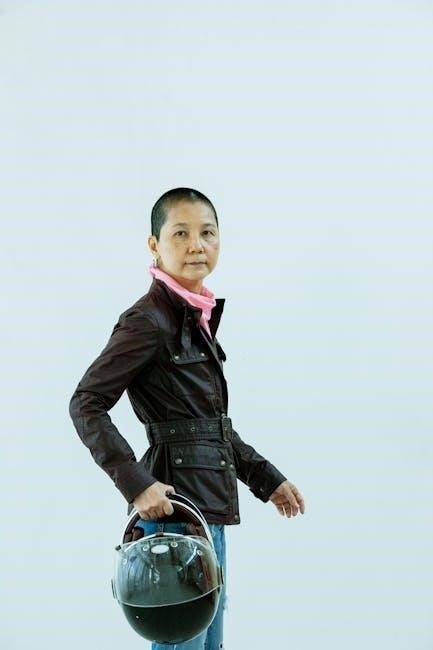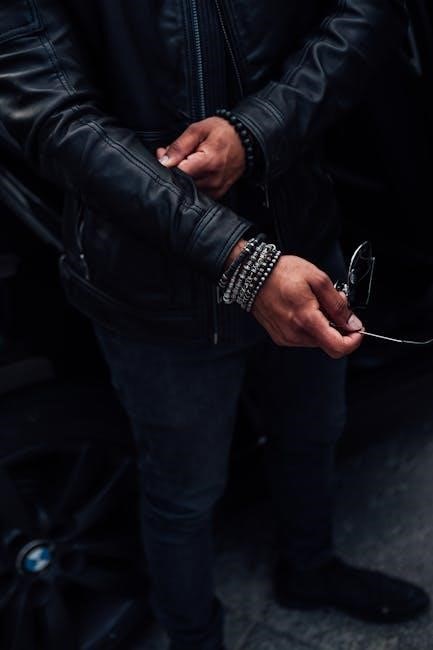A well-fitting motorbike jacket is essential for safety, comfort, and style. Proper sizing ensures optimal protection, mobility, and a comfortable riding experience, regardless of your riding style or terrain.
Why Proper Fit Matters for Safety and Comfort
A proper-fitting motorbike jacket ensures optimal safety by keeping protective armor in place during impact. It also enhances comfort, allowing unrestricted movement and reducing fatigue on long rides. A jacket that is too tight can restrict mobility, while one that is too loose may flap in the wind, causing discomfort. The right fit balances protection, flexibility, and comfort, making it essential for an enjoyable and safe riding experience.

How to Measure Yourself for a Motorbike Jacket
Use a soft tape measure to accurately measure your chest, natural waist, and shoulders. This ensures the best fit for comfort and protection while riding.
Step-by-Step Guide to Accurate Measurements
Begin by measuring your chest, ensuring the tape is level and not too tight. Next, measure your natural waistline, keeping the tape straight. Then, measure the circumference of your dominant arm at the bicep. Finally, measure your shoulder width from one tip to the other. These measurements will help you determine the perfect jacket size for a comfortable and secure fit.
Essential Tools: Soft Tape Measure and How to Use It
A soft tape measure is crucial for accurate sizing. Wrap it around your chest, keeping it level and parallel to the floor. Ensure it’s snug but not tight. For sleeves, measure from the center back of your neck to your wrist. This ensures proper fit and comfort, avoiding restrictive or loose areas. Always stand upright and relax your muscles for precise measurements.

Understanding Jacket Styles and Their Fit
Different motorbike jacket styles fit differently, catering to specific riding needs. Racing jackets are snug for aerodynamics, while touring styles offer a relaxed fit for comfort during long rides.
Differences in Fit: Racing, Touring, and Casual Jackets
Racing jackets are designed for a snug, aerodynamic fit, prioritizing performance and protection at high speeds. Touring jackets offer a more relaxed fit, emphasizing comfort during long rides. Casual jackets provide a loose, versatile fit for everyday wear, blending style with functionality. Each style caters to specific riding needs, ensuring optimal comfort, mobility, and protection based on the rider’s preferences and terrain. Proper fit is crucial for safety and enjoyment.
How Riding Style Influences Jacket Size
Your riding style significantly impacts the ideal jacket size. Aggressive riders may prefer a tighter fit for better control, while cruisers often opt for a looser, more comfortable fit. Touring riders need a balance of mobility and protection, often choosing jackets with adjustable features. Ensuring the jacket fits your riding posture and movement is key for both safety and comfort, regardless of the terrain or speed.
Fabric and Material Considerations
Leather, textile, and mesh fabrics offer varying fits. Leather jackets are snug and durable, while textiles provide flexibility and mesh offers breathability, each impacting size selection differently;
How Leather, Textile, and Mesh Jackets Fit Differently
Leather jackets fit snugly, offering a structured, durable design that molds to the body over time. Textile jackets provide a more relaxed fit with added flexibility. Mesh jackets prioritize breathability, often featuring adjustable panels for a tailored feel. Each material’s unique properties influence sizing, ensuring comfort and protection tailored to specific riding needs and preferences.
Stretch Panels and Adjustable Features for Better Fit
Stretch panels in motorbike jackets enhance flexibility, allowing unrestricted movement while riding. Adjustable features like waist straps, cuff closures, and arm adjustments ensure a customizable fit. These elements optimize comfort and minimize bulk, providing a secure yet flexible design that accommodates different body types and riding positions for improved performance and safety on the road.

Tight vs. Loose: Finding the Right Balance
Achieving the right balance between tight and loose ensures optimal protection and comfort. A snug fit prevents shifting during rides, while a slightly looser fit allows better mobility.
Pros and Cons of a Tight Fit
A tight motorbike jacket offers superior protection and a sleek, stylish appearance. It reduces wind resistance and keeps safety features like armor in place. However, a overly tight fit can restrict movement and cause discomfort, especially during long rides. It may also lead to chafing or limited ventilation, potentially affecting breathability. Balancing tightness with mobility is crucial for optimal comfort and safety on the road.
When a Loose Fit is More Practical
A loose-fitting motorbike jacket can be more practical for casual rides, layering, or varying weather conditions. It allows for better mobility and comfort, especially during long trips. However, a loose fit may compromise protection and create wind buffeting at higher speeds. Balancing comfort and safety is key, as a loose jacket might shift during riding, potentially reducing its protective effectiveness. Practicality depends on riding style and personal comfort preferences.

Common Fit Issues and Solutions
Restrictive sleeves, tight shoulders, and gapping at the waist are common issues. Adjustable cuffs, armor placement, and stretch panels can help achieve a more tailored, comfortable fit.
Addressing Discomfort in the Shoulders and Sleeves
Shoulder discomfort often arises from a jacket that’s too tight or too loose. Ensuring proper measurements and considering riding posture can help. For sleeves, check if they allow full arm movement without restriction. Adjusting armour placement or opting for jackets with stretch panels can enhance flexibility. Additionally, ensuring the jacket isn’t overly bulky in the shoulders can improve both comfort and mobility during rides.
How to Ensure Proper Torso and Waist Fit
A well-fitting jacket should hug the torso comfortably without restricting movement. Measure around the natural waistline, ensuring the jacket covers your lower back when seated. Adjustable waist straps or stretch panels can customize the fit. Avoid overly tight jackets that restrict breathing or loose ones that bunch up while riding. Proper torso fit ensures optimal protection and mobility, making long rides more enjoyable and safe.
The Importance of a Well-Fitting Jacket
A well-fitting jacket ensures safety, comfort, and mobility while riding. Proper fit prevents restrictive movement and provides optimal protection in case of impact, enhancing overall riding confidence.
Safety: How Fit Affects Protection in a Crash
A well-fitting motorbike jacket is crucial for safety in the event of a crash. Proper fit ensures that protective armor and padding remain in place, safeguarding vital areas like shoulders, elbows, and spine. A loose jacket may shift during impact, reducing its protective effectiveness. Similarly, a jacket that is too tight can restrict movement, potentially hindering control or increasing the risk of injury. A snug, balanced fit ensures optimal protection and mobility, allowing the jacket to function as designed during impact.
Comfort and Mobility for Long Rides
A well-fitting motorbike jacket enhances comfort and mobility on long rides, ensuring freedom of movement while maintaining protection. A jacket that is too tight can restrict articulation, while one that is too loose may flap in the wind, causing discomfort. Adjustable features like stretch panels and articulated sleeves improve flexibility, allowing riders to move naturally. Proper fit also prevents fatigue, enabling riders to stay focused and comfortable during extended journeys.

Final Tips for Choosing the Right Size
Consult size charts and brand-specific guides to ensure accuracy. Consider adjustable features for a tailored fit and test the jacket while in riding position if possible.
Consulting Size Charts and Brand-Specific Fit Guides
Always refer to the manufacturer’s size charts for accurate measurements. Brands often have unique fit profiles, so comparing your measurements to their guidelines ensures the best fit. Pay attention to specific features like adjustable cuffs or hem adjustments. If possible, try the jacket on in your riding position to confirm comfort and mobility. This step is crucial for long rides and varying weather conditions.
Trying Before Buying: In-Store vs. Online
Trying a jacket before purchasing ensures the best fit and comfort. In-store visits allow you to assess how the jacket feels in your riding position and check for proper mobility. Online shoppers should rely on detailed size charts and customer reviews to guide their choice. If unsure, consider brands with flexible return policies to exchange sizes without hassle.

Additional Features to Consider
Additional features like armor, pockets, and ventilation enhance both functionality and fit, ensuring comfort and practicality for riders of all styles.
Armor, Pockets, and Ventilation: How They Impact Fit
Armor adds bulk, requiring careful sizing to ensure protection without restricting movement. Pockets can affect fit if overfilled, while ventilation enhances comfort but may alter how the jacket sits. Considering these features ensures a balance of protection, practicality, and comfort tailored to your riding style and needs.
Custom Adjustments for a Personalized Fit
Custom adjustments like adjustable cuffs, hem drawstrings, and waist straps allow riders to tailor the jacket to their body. Stretch panels provide flexibility, while removable liners offer seasonal adaptability. These features ensure a fit that maximizes comfort, mobility, and protection, making the jacket suitable for various riding conditions and personal preferences.
